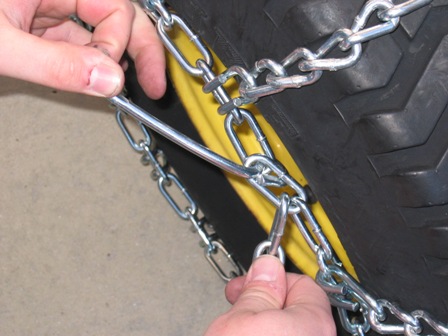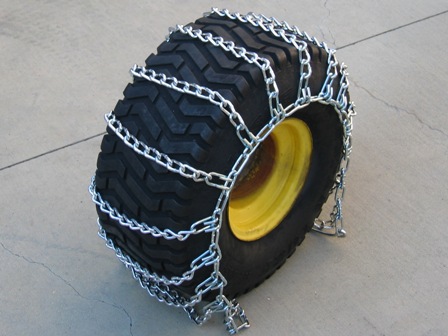To install chains on tractor tires, place the chain over the top of the tire and adjust it evenly. Secure the chains by fastening the hooks or connectors tightly.
Enhancing the traction of your tractor through the winter months is crucial for maintaining productivity in agricultural operations. Installing chains on your tractor tires can significantly improve grip on icy or snow-covered surfaces, preventing slippage and ensuring safe and efficient performance.
Understanding the proper technique for installing chains on tractor tires is essential to guarantee a secure fit that maximizes traction without causing damage to the tires. In this guide, we will provide step-by-step instructions on how to install chains on tractor tires effectively, ensuring your equipment is ready for the challenges of winter weather conditions.

Credit: m.youtube.com
Preparing The Tractor Tires
Preparing the Tractor Tires for installing chains involves performing specific steps to ensure their compatibility and safety. This includes choosing the right chains and inspecting the tires thoroughly. By following these guidelines, you can effectively prepare your tractor tires for the installation of chains, enhancing traction and stability in challenging conditions.
Choosing The Right Chains
- Consider the tire size and type to determine the suitable chain size and pattern.
- Refer to the tractor’s manual or contact a professional for guidance on the appropriate chains.
- Ensure the chains are compatible with the tractor’s tire clearance and do not interfere with any components.
Inspecting The Tires
- Check the tire pressure and adjust it to the manufacturer’s recommended levels if necessary.
- Examine the tread depth to ensure it meets the minimum requirement for chain installation.
- Look for any signs of damage, such as cracks or punctures, and address them before proceeding with chain installation.

Credit: www.instructables.com
Installing The Chains
When it comes to installing chains on tractor tires, it’s essential to follow the right steps to ensure proper installation and maximize traction.
Laying Out The Chains
- Lay the chains flat on the ground near the tractor tire.
- Untangle any knots or twists in the chains to ensure they are ready for installation.
Attaching The Chains
- Position the chains evenly around the tractor tire.
- Start by securing the bottom of the chains behind the tire.
- Pull the chains over the tire evenly on both sides.
- Connect the chain fasteners securely to keep the chains in place.
Tightening And Adjusting The Chains
Securing The Chains
When securing the chains on your tractor tires, ensure each connection point is properly fastened.
To secure the chains effectively, use the provided fastening devices such as hooks or locking mechanisms.
Checking For Proper Tension
Regularly check the tension of the chains to ensure they are snug and secure on the tires.
Adjust the tension as needed by adding or removing chain links to achieve the proper fit.
Ensuring Proper Alignment
Make sure the chains are aligned evenly on both tires for balanced traction and performance.
Inspect the chains for any twists or tangles that may affect their effectiveness while in use.

Credit: blog.machinefinder.com
Testing And Safety Measures
When it comes to installing chains on tractor tires, testing and safety measures are crucial to ensure smooth operations and prevent accidents. Proper testing of the tire traction and ensuring adequate clearance are essential steps in this process. Let’s delve into these critical aspects in more detail.
Testing The Tire Traction
Before installing chains on tractor tires, it’s imperative to assess the tire traction to determine if chains are necessary. This can be achieved by performing a simple test by driving the tractor on a slippery surface or a patch of loose soil. If the tires demonstrate inadequate traction and slip easily, it indicates the need for chains to enhance grip and stability.
Ensuring Proper Clearance
When installing chains on tractor tires, ensuring proper clearance is paramount for smooth and safe operation. Measure the clearance between the tire and other components of the tractor to prevent any interference or rubbing. Ensure that the chains do not make contact with any parts of the tractor’s body or chassis, taking into account any potential movement or flex during operation.
Removing And Storing The Chains
When the winter season arrives, it’s time to equip your tractor tires with chains to enhance traction on icy and snowy surfaces. However, just like any other equipment, the chains need to be removed and stored properly to ensure their longevity and usability in the next winter. In this article, we will take you through the step-by-step process of removing and storing the chains effectively.
Removing The Chains
- Start by parking your tractor on a flat surface, ensuring that the engine is turned off and the parking brake is engaged.
- Using a wrench, loosen the tensioners on the chains before completely removing them. This will make it easier to disengage the chains from the tire.
- Starting from the top, carefully disengage the chains from the tire grooves, making sure not to damage any components of the tractor or the chains themselves.
- Once the chains are completely disengaged, carefully remove them from the tire. It is advisable to wear gloves during this process to protect your hands from any sharp edges or debris.
- After removing the chains from one tire, repeat the process for all the other tires on your tractor.
Cleaning And Storing The Chains
After removing the chains, it’s important to clean and store them properly to prevent any rust or damage. Follow these steps to ensure the chains are in good condition for next winter:
- Using a stiff brush or high-pressure washer, clean the chains thoroughly to remove any dirt, debris, or salt residue that may have accumulated during use.
- Inspect the chains for any signs of damage or wear. If you notice any broken links or excessive wear, it might be time to consider replacing the chains before the next winter season.
- Once the chains are clean and dry, it’s time to store them. Coil the chains neatly and secure them with zip ties or bungee cords to prevent tangling.
- Find a cool, dry place to store the chains, away from direct sunlight and moisture. A storage container or a dedicated hook on the wall can be an ideal option.
- Before storing the chains, consider spraying them lightly with a rust inhibitor or storing them in a sealed bag to prevent corrosion.
By following these simple steps, you can remove, clean, and store your tractor tire chains with ease, ensuring their longevity and effective use in the next winter season. Taking care of your equipment not only prolongs its lifespan but also guarantees optimal performance when you need it the most.
Frequently Asked Questions Of How To Install Chains On Tractor Tires
How Do You Put Chains On Garden Tractor Tires?
To put chains on garden tractor tires, start by parking the tractor on a flat surface. Then, wrap the chains around the tires, making sure they are evenly spread out. Connect the ends of the chains using the provided fasteners or hooks.
Tighten the chains as needed to ensure a snug fit.
What Is The Correct Way To Put On Tire Chains?
Carefully follow these steps to correctly put on tire chains: 1. Lay out the chains flat on the ground. 2. Drive the vehicle forward a bit to center the chains. 3. Connect the chains, then drive again to secure them. 4.
Check the tightness and adjust if necessary. 5. Drive slowly to test the chains’ fit.
How Do You Tighten Tractor Tire Chains?
To tighten tractor tire chains, use a chain tightener tool or pliers to adjust the tension evenly.
Do Tire Chains Help On A Tractor?
Yes, tire chains can provide added traction for a tractor on slippery surfaces like snow or mud.
Conclusion
Installing chains on tractor tires is essential for better traction in challenging conditions. With the right tools and techniques, you can ensure safety and efficiency in your agricultural operations. Remember to check local regulations and guidelines before installing chains, and seek professional help if needed.
Happy farming!
- How Much Does a Ford 9N Tractor Weigh - May 20, 2024
- How Many of My Exact Car were Made: Uncovering the Rarity - May 20, 2024
- How to Find Out What Someone Drives: Discover the Truth - May 20, 2024



